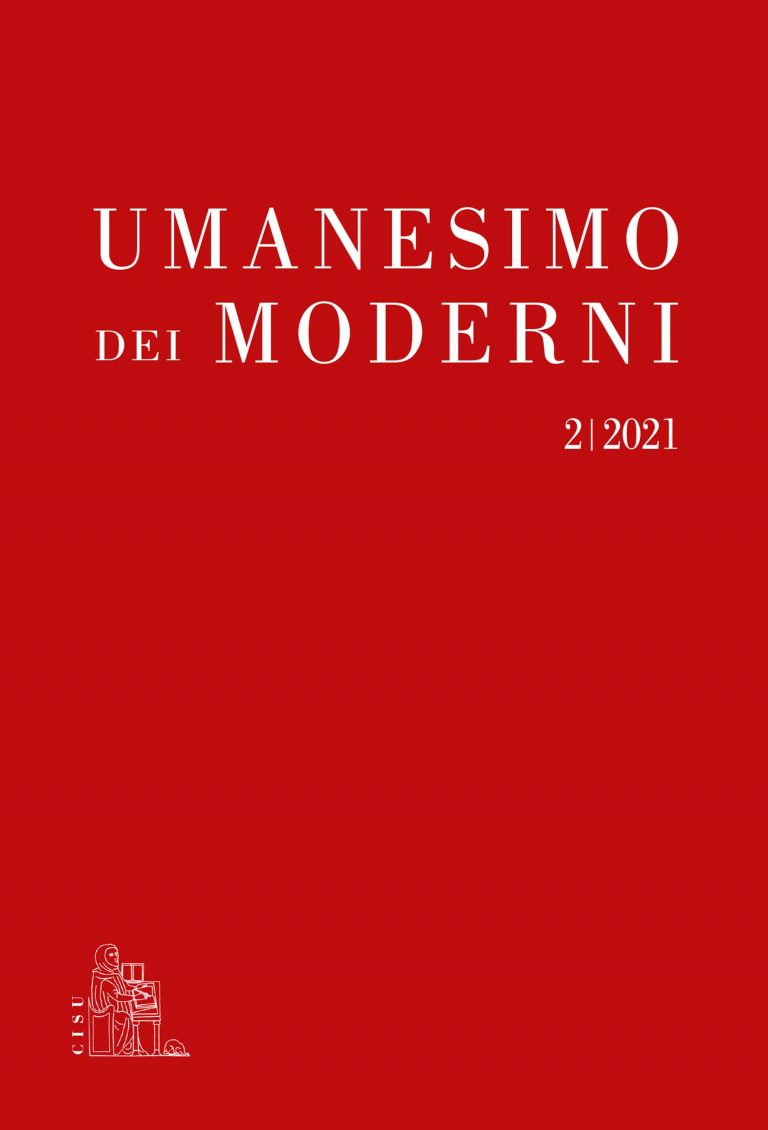2 | 2021 Messina, Centro Internazionale di Studi Umanistici, 2020, 320 pp.; 25 cm. ISSN 2724-0835 ISBN 978-88-87541-84-7 € 70 INDICE GENERALE Vincenzo Fera, Edizioni in cerca d’identità Giovanni Barberi Squarotti, «Con la coscienza di compiere un dovere»: i Poemi del Risorgimento nell’edizione di Maria Pascoli (1913) Massimo Castoldi, Giovanni Pascoli: varianti d’oltre tomba Giorgio Forni, Maria editrice di Giovanni. Qualche caso dantesco e il Piccolo Vangelo Luca Verrelli, Per l’edizione delle prose pascoliane: i Discorsi Annarita Zazzaroni, Pubblicare i testi teatrali: Gretchen’s Tochter – La figlia di Ghita Caterina Malta, «Un complesso sistema d’edifici, lasciato a mezzo».…
Categoria: Rivista UM
Umanesimo dei moderni apre il suo osservatorio sulla moderna letteratura italiana, promuovendo, in linea con l’identità scientifica del Centro di studi umanistici di Messina, un perimetro di ricerca che riporti in superficie le vie interrotte o obliterate della tradizione. E ciò attraverso percorsi esplorativi che si addentrino negli scrittoi degli autori, nei loro archivi, a focalizzare metodi di lavoro, chiarire aspetti del processo creativo, contribuendo al rinnovamento delle prospettive ecdotiche e culturali. Più che rispondere a una vocazione erudita si tratta, lungo la scia dionisottiana, di rendere il documento chiave di lettura delle ramificazioni della storia, recuperando il senso della grande categoria dell’umanesimo come spazio che genera e riammette al suo interno le innumerevoli effrazioni del moderno. Non è tanto, o non solo, un interesse verso la permanenza del classico e le sue metamorfosi, ma una lente proiettata a valle sui modi in cui la letteratura italiana proprio nel rapporto col passato acquista coscienza di sé. Saggi articolati ma anche rapide acquisizioni, affidate al respiro breve della ‘tessera’, costituiscono l’ossatura della rivista, che, seppure disponibile ad accogliere maniere diverse di leggere la dinamica antico/moderno, conferma la fedeltà a un modello ermeneutico centrato sul testo, con gli strumenti di una filologia intesa come scienza integrale. La rivista trova un suo coerente e più ampio deflusso nella collana omonima, Umanesimo dei moderni. Testi e studi, ispirata agli stessi presupposti teorici e metodologici.
Direttore responsabile
Vincenzo Fera
Direzione
Giovanni Barberi Squarotti, Massimo Castoldi, Carla Chiummo, Paola de Capua, Giorgio Forni, Daniela Gionta, Caterina Malta, Florian Mehltretten
Comitato scientifico internazionale
Giovanni Benedetto, Maria Cannatà, Massimo Danzi, Michele Feo, Laura Melosi, Stefano Prandi, Dirk Sacré, Valerio Sansotta, Maria Antonietta Terzoli, Xavier Van Binnebeke
Redazione
Antonino Antonazzo, Francesco Galatà
La Rivista ha periodicità annuale.
I saggi pervenuti alla Rivista sono affidati alla valutazione di due revisori, secondo un procedimento rigorosamente anonimo, e in seguito sottoposti al vaglio della Direzione. La Rivista pubblica online (http://www.cisu.unime.it) i nomi dei revisori che hanno collaborato alle varie annate.
«Umanesimo dei moderni» is a peer-reviewed journal.
Umanesimo dei moderni, 1
1 | 2020 Messina, Centro Internazionale di Studi Umanistici, 2020, 424 pp.; 25 cm. ISSN 2724-0835 € 80 INDICE GENERALE Francesco Galatà, Nello studio del pittore Bersani. Dialoghi del giovane Pascoli sulle poetiche del secondo Ottocento Claudia Castorina, Pascoli e i giudici di Amsterdam: il caso di Phidyle Salvatore Guarino, Note su un’immagine visionaria in Pascoli: i rerum somnia di Myrmedon 61-64 Francesco Tripodi, L’Èra nuova di Giovanni Pascoli tra storia del testo e metrica neoclassica Maria Cannatà Fera, «Inter odoratas Erycinae munera citros». Giovanni Pontano in Pascoli? Sebastiano Valerio, «Rabbiosa fame» e «sacra fame». Dante, la lezione…

